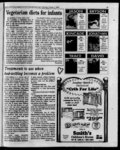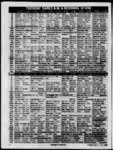| Show Special Advertising Supplement to the Standard-Examin- er Saturday February 7 1 998 i bring a new baby home or already have toddlers or young children it is important to ask yourself “Is my home safe for small children?” Injury is the number-on- e killer of children Luckily it is also the most preventable This childproofing checklist will help you provide a safe environment for your family Have a first-ai- d kit with items handy at all appropriate times Buy medicines and other household products with childproof caps Be sure to keep these out of reach of children When cooking use back burners and be sure to keep pot handles turned inward so little hands can’t grab them Put safety child-resista- nt ' I : - i I — HowtotMldproof your home Whether you are about to f - -- g latches on all cabinets and drawers containing harmful substances Cover all unused electrical sockets Keep syrup of ipecac (used to induce vomiting in some cases of poisoning) in the home at all times Use only upon the advice of a poison control center or emergency department Keep toys with small parts and other small objects out of reach of toddlers and young children If you have a pool install a d fence with an automatic childproof gate Be sure all windows are secure Install window guards to keep children from falling out Be sure cords from draperies and blinds are out of four-side- & V & tog f reach of cribs or children’s beds Keep emergency numbers on EVERY telephone in your home List the ambulance service fire department police department regional poison control center and the emergency department Don’t rely on a “memoiy” telephone— it may not work in a power outage Install smoke detectors and check batteries twice a year If you keep firearms in your home store them unloaded and locked Firearms and ammunition should be stored separately Remember prevention is a priority and injuries can be avoided The American College of Emergency Physicians (ACEP) is a national medical specialty society representing more than 18000 emergency physicians who specialize in emergency medicine Source: NAPS BR’A’LEEFAKIISI Helping children deal with anger T y uytmie onset-Mom- my loves you! How can parents help children grow up to be teenagers and adults who work out conflicts in nonviolent ways? Here are some sug- gestions : Plan for warm and caring times together When there’s a close trusting bond children are more likely to try to please their parents and it’s within a loving family that we all learn to control our behavior Talk about angry feelings When children know parents care deeply about them and what they’re feeling they are more likely to talk about feelings rather than act them out Find healthy outlets so children can channel their energies when they’re angry Offer things like crayons and paper for painting a mad picture clay for pounding musical instruments or puppets for making a play “Angry feelings are a natural part of being human” says Fred Rogers of the television program Mister Rogers’ Neighborhood “When we were children and the adults we loved allowed us to know that our angry feelings were a normal part of loving and being loved those adults gave us a great and lifelong gift” says Rogers Source: NAPS (MEsma Bom: Bom: Juns IS 1997 Slbs 11 ox Daughter of Michael & Jana Plowman 1997 Our Little Angel' Her proud parents are Ron& Jennifer Pierce of Roy Utah RiWA’KJKJ Bom: Novsmbsr 23 1996 Daughter of Jason & ‘T- - Jeanna : Burnett of j f r-’-- jj - Riverside |












































































































